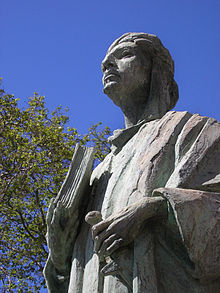Almansor
Abu Amir Muhammad ibn Abdallah ibn Abi Amir ( Arabic أبو عامر محمد بن عبد الله بن أبي عامر, DMG Abū ʿĀmir Muḥammad b. ʿAbd Allaah b. Abī ʿĀmir ), called al-Mansur bi-llah /المنصور بالله / al-Manṣūr bi-llāh / 'the victorious with God', known in German as Almansor (* around 938 probably near Algeciras ; † August 10, 1002 in Medinaceli ) was the de facto sole ruler from 978 to 1002 for the Umayyad caliph in the caliphate of Cordoba .
Live and act
Muhammad ibn Abi Amir was born into a family that 711 ibn Ziyad Tariq from Yemen after al-Andalus immigrated and lands at Algeciras invested was. He studied law, grammar and literature in Córdoba and started working in the administration as secretary of the court chancellery.
After the death of the caliph al-Hakam II (976), his underage son Hisham II came to the throne of the caliphate. With the support of Subh, the mother and regent of Hisham II, the vizier al-Mushafi and General Ghalib, a conspiracy of the eunuchs who wanted to raise another Umayyad to the throne in Cordoba was suppressed. After Abi Amir al-Mansur had married the daughter of General Ghalib al-Asma, he succeeded in eliminating the vizier al-Mushafi. Later he asserted his power as a chamberlain against Ghalib and thus controlled the power in the caliphate . After Abi Amîr had thwarted a new conspiracy of the eunuchs in 978, he de facto ruled the Caliphate of Cordoba , with Hisham II being excluded from exercising power, but remaining the caliph as a withdrawn scholar.
To secure his position, Almansor disbanded the Umayyad slave guard and built a new army of Moroccan mercenaries. The traditional division of troops by tribes was abandoned. This military reform led to a renewed wave of Berber immigration to Andalusia after the 8th century , whose opposition to the Arabs would later contribute to the downfall of the caliphate.
With the new army, Abi Amir undertook 52 campaigns against the Christian empires in northern Spain. Thus in 981 Zamora was conquered and in 985 Barcelona sacked. In 987 he devastated Coimbra , which then remained uninhabited for 7 years. In 988 León was conquered and on August 10, 997 the heavily fortified Christian pilgrimage center Santiago de Compostela in Galicia was destroyed, but out of respect the grave of the Apostles James the Elder was left untouched. A few thousand Christian survivors had to carry the bells from Compostela to Cordoba as slaves, where they were remelted into lamps for the mosque.
Abi Amir also renewed rule in northern Morocco, installing his son `Abd al-Malik in Fez in 998 as governor. Because of these successes, Abi Amir took the nickname al-Manṣūr bi-llāh , from which the European name "Almansor" is derived. This step was an outrageous presumption because the title was reserved for caliphs alone. In 996 he even assumed the title of king. He founded the new palace city of al-Madina az-Zahira ("the shining city"), to which the administration from the Umayyad Medina-Azahara residence was also outsourced. He started with his own coinage and used his own seals. Abi Amir al-Mansur also promoted art and culture, but had the library of the devoted Caliph Al-Hakam II cleansed of philosophical writings in order to secure the goodwill of Islamic legal scholars. On the other hand, he last expanded the Great Mosque (987–988) of Córdoba and also expanded the city itself.
In August 1002, Abi Amir al-Mansûr died in Medinaceli while returning from a campaign. Christian chroniclers posthumously accused him of a defeat in the alleged battle of Calatañazor , which never took place. His eldest son ʿAbd al-Malik (1002–1008) was his successor as chamberlain and regent. (See also: Amiriden )
supporting documents
- ↑ 27. Ramadan 392 H
- ^ Antonio Muñoz Molina : City of the Caliphs. Historical forays through Cordoba. Rowohlt, Reinbek 1994, ISBN 978-3-499-13281-0 , p. 192.
literature
- André Clot : Moorish Spain: 800 years of high Islamic culture in Al Andalus . Albatros, Düsseldorf 2004, ISBN 3-491-96116-5 .
- Wilhelm Hoenerbach : Islamic History of Spain: Translation of the Aʻmāl al-a'lām and additional texts. Artemis, Zurich / Stuttgart 1970.
- Arnold Hottinger : The Moors. Arabic culture in Spain . Fink, Munich 1995, ISBN 3-7705-3075-6 .
- Antonio Muñoz Molina : City of the Caliphs. Historical forays through Cordoba. Rowohlt, Reinbek 1994, ISBN 978-3-499-13281-0 .
- Stephan and Nandy Ronart: Lexicon of the Arab World. Artemis, Zurich / Munich 1972, ISBN 3-7608-0138-2 .
- Philippe Sénac: Al-Mansûr, le fléau de l'an mil . Perrin, Paris 2006, ISBN 2-262-01578-3 .
Web links
| personal data | |
|---|---|
| SURNAME | Almansor |
| ALTERNATIVE NAMES | Almansor, Abi Amir; al-Mansûr, Abi Amir;ألمنصور; al-Mansor bi-Allah |
| BRIEF DESCRIPTION | Regent in the Caliphate of Cordoba |
| DATE OF BIRTH | uncertain: 938 |
| PLACE OF BIRTH | unsure: Algeciras |
| DATE OF DEATH | August 10, 1002 |
| Place of death | Medinaceli |

